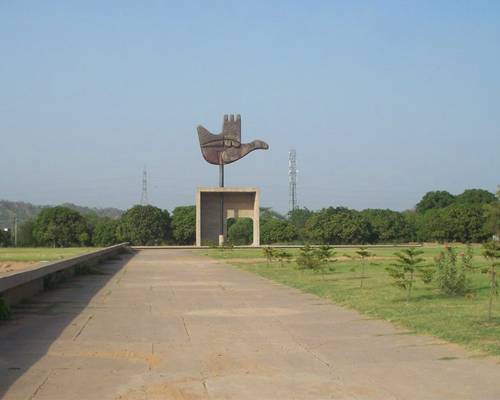The Open Hand Monument: Chandigarh’s Symbol of Peace, Unity, and Free Expression
Open Hand Monument Chandigarh – History, Architecture & Symbolic Significance
History of the Open Hand Monument
The Open Hand Monument in Chandigarh stands as one of the most iconic creations of legendary architect Le Corbusier. Conceived during the 1950s as part of the city’s grand Capitol Complex, the monument reflects Corbusier’s vision of a progressive, democratic society. He designed this masterpiece as a space where citizens could gather, share concerns, and express ideas freely. Over decades, the monument has evolved into a cultural and historical emblem, representing Chandigarh’s foundations rooted in transparency, peace, and modern urban planning.
Architectural Brilliance and Unique Engineering
Standing 26 metres (85 feet) tall and weighing nearly 50 tonnes, the Open Hand Monument is an engineering marvel. Crafted from industrial-grade metal sheets, the sculpture is mounted on a pivot, enabling it to rotate with the wind—just like a weathercock. This dynamic movement symbolizes adaptability, openness, and constant dialogue. Its placement in Sector 1, within the Capitol Complex (a UNESCO World Heritage Site), adds to its architectural significance, as it aligns perfectly with Le Corbusier’s modernist design principles and his emphasis on harmony between structures and the natural environment.
Symbolism and Cultural Importance
More than a pioneering architectural structure, the Open Hand Monument carries a powerful message for the world: “Open to Give and Open to Receive.” It embodies peace, unity, and the free flow of ideas—values at the core of Chandigarh’s identity. The monument’s design encourages the exchange of thoughts among people, promoting social harmony and collective growth. As the official emblem of Chandigarh, it draws visitors, scholars, and architecture enthusiasts from across the globe, making it a timeless symbol of expression and openness.
Places To Visit

History & Vision
The Open Hand Monument has its roots in the early planning years of Chandigarh when Le Corbusier envisioned a city built on transparency, peace, and civic harmony. Created in the 1950s, the monument was designed as a gathering point where citizens could express their views and share ideas openly. Its presence in the Capitol Complex symbolizes the democratic spirit on which the city was founded, making it one of the most meaningful landmarks in Chandigarh’s history.
Architectural Marvel


Symbolic Essence
Top Attractions & Activities
Top Attractions
- **Iconic Rotating Structure** – The 26-meter-high metal hand rotates freely with the wind, creating a mesmerizing visual experience.
- **Le Corbusier’s Masterpiece** – A globally recognized architectural creation representing modernist design at its finest.
- **UNESCO Capitol Complex** – Located within the prestigious Capitol Complex, a UNESCO World Heritage Site.
- **Symbol of Peace & Unity** – Represents the philosophy of “Open to Give, Open to Receive,” drawing visitors seeking depth and meaning.
- **Photography Hotspot** – The monument’s grand scale and open surroundings make it ideal for memorable photography.
- **Serene Open Spaces** – Peaceful, spacious grounds perfect for walks, reflection, and sightseeing.
Activities to Engage With
- **Guided Architecture Walks** – Join curated tours to learn about the monument’s design, history, and Le Corbusier’s vision.
- **Photography Sessions** – Capture striking angles, shadows, and the rotating hand against Chandigarh’s open skyline.
- **Cultural Discussions** – Engage in open talks or informal meetups inspired by the monument’s theme of idea-sharing.
- **Sketching & Art Practice** – A perfect spot for artists to draw, sketch, or paint the iconic structure.
- **Peaceful Strolls** – Enjoy calm surroundings ideal for reflective walks and appreciating modern architecture.
- **Sunrise & Sunset Viewing** – Experience the monument’s silhouette glowing beautifully during golden hours.
Location and Accessibility
The Open Hand Monument is located in Sector 1 of Chandigarh, within the world-famous Capitol Complex—a UNESCO World Heritage Site. Its central position makes it easily accessible from all major parts of the city. Visitors can reach the monument via local buses, auto-rickshaws, taxis, or private vehicles, with well-maintained connecting roads leading directly to the complex. Ample open space and pedestrian-friendly pathways make the site convenient for walking tours as well. Its proximity to landmarks like the High Court, Secretariat, and Legislative Assembly ensures smooth navigation, making the monument both easy to find and pleasant to explore.
Visitor Tips
| No. | Services | Details |
|---|---|---|
| 1 | Guided Tours | Professional guides offer insightful tours explaining the art, history, and collections in detail. |
| 2 | Educational Programs | Workshops and lectures are organized for students and art enthusiasts throughout the year. |
| 3 | Art Restoration | The museum provides art conservation and restoration services to preserve cultural heritage. |
| 4 | Photography Access | Photography is permitted inside selected areas with a small fee for cameras or mobiles. |
| 5 | Library Access | Visitors can access a small research library featuring books on Indian art and architecture. |
| 6 | Souvenir Shop | A gift shop offers art prints, books, and keepsakes inspired by the museum’s collections. |
What to See and Experience
| No. | What to See & Experience |
|---|---|
| 1. | The rotating metal hand structure that moves gracefully with the wind. |
| 2. | Stunning views of the Capitol Complex designed by Le Corbusier. |
| 3. | Expansive open spaces ideal for photography and quiet reflection. |
| 4. | Symbolic interpretation of the “Open to Give, Open to Receive” philosophy. |
| 5. | Artistic inspiration for sketching, drawing, and architectural study. |
| 6. | Beautiful sunrise and sunset views highlighting the monument’s silhouette. |






